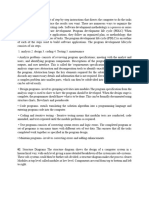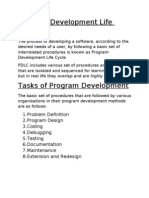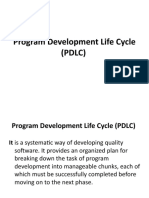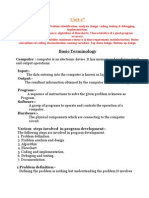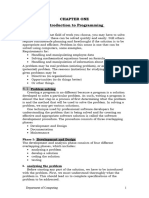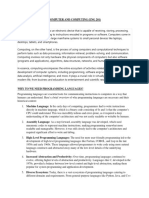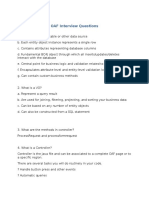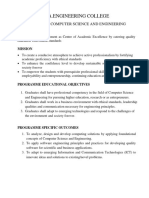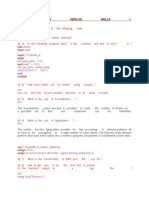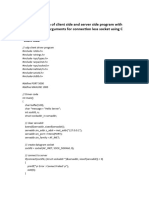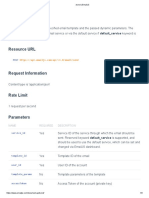Program Development Cycle
When coming up with a computer program, there are several steps or stages the development
team should observe.
A. Analyzing the Problem
This is indeed the first Step to creating a program. And it involves getting information about
the program you are about to create. It is In this stage that you determine what you want to
achieve with your program, how you want to achieve it, etc. These informations are very
important for the programmer because it provides him the basis for planning about the
program and to control the possible difficulties that may arise.
B. Design
A computer program is a product. Thus, just like any other product that undergoes
production, a program should be designed first before coding. The design should clearly
outline the program’s algorithm (a step-by-step sequence of solving a given problem).
Before writing the actual program using any programming language, a programmer can
design/outline the flow of the program instructions using design tools such as pseudocode or
a flowchart
i. Pseudocode is an informal way of writing the flow a program.
It only represents the algorithm of the program in natural language and mathematical
notations.
Pseudocode can be developed using simple English language statements.
After writing the pseudocode, you now write the actual program to implement the
pseudocode
For example
//Compute the sum of 2 numbers:
Start
Input number1
Input number2
Compute total = number1 + number 2;
Print total;
End
ii. A flowchart represents an algorithm using a diagram. Specific graphical symbols are
used to demonstrate the flow or steps of execution.
For example, A program to grade student marks would be represented using a
flowchart as follows
1
�C. Coding
In this stage the programmer writes the instructions in a language understood by the computer
to solve the problem(s) drafted out in the previous stages. It's obvious how, many
programmers jump the initial stages and start writing bunch of codes. Because all the
processes of Coding depends upon the information we obtained in the previous stages.
NB: Choice of language depends entirely upon the requirements and facilities available with
a language in contrast with what you want to achieve.
D. Testing & Debugging
In this stage we test the program by entering dummy datas (includes usual, unusual and
invalid data) to check how the behavior of the program when given such datas. When issues
are identified during testing, the debugging process starts where the identified errors are
fixed.
E. Deployment
Once the software application has undergone testing , it is delivered to the customer. This
may involve installing the program on client’s computer and helping the end-users run the
program through user training
F. Maintenance
While the program is in use, there may be unique issues that come up and need to be
addressed. These customer issues are solved in this maintenance stage.
To help mitigate the amount of maintenance that needs to be done, teams may choose to first
release the product to a smaller population of customers. This can offer insight into how the
2
�product is performing and the development teams can make any last adjustments prior to its
final release.
G. Documentation
Every stage during program development should be documented for future reference. Many
programmers ignore this phase but it is critical for any computer program.
Types of documentation:
i. User Manual.
ii. Technical Manual.
The User Manual provides the user with the complete information on how to operate the
program, and what needs to be done when the user encounters a problem while using the
program.
The Technical Manual contains the technical information about the program. This is
necessary to provide users technical details of the program, and what to do when the system
is not working as supposed or requires modifications.
NB: documentation should start immediately after the problem analysis stage. Thus, it is not
the last stage but a continuous process. Even the testing and debugging stage should be
documented.




